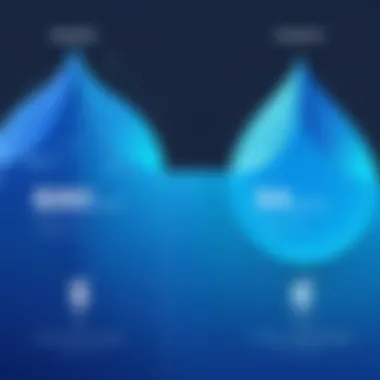Understanding DigitalOcean Droplet Pricing Plans


Intro
Understanding the pricing structure of DigitalOcean's Droplets is vital for businesses seeking cloud solutions. This guide will explore key features, various pricing models, and the implications of selecting the right Droplet for specific needs. With the rise of cloud computing, organizations must navigate through options that align with their goals and budget.
DigitalOcean offers a range of Droplets, each catering to different performance requirements and workloads. This guide delves into the characteristics that distinguish these offerings, highlighting the value proposition for informed decision-making.
As cloud technology evolves, so does the necessity for clarity in costs associated with it. The intricacies of pricing can be daunting, but with a thorough understanding, businesses can avoid pitfalls and capitalize on opportunities. This article aims to provide that understanding, ensuring that readers leave with a richer perspective on DigitalOcean’s financial landscape.
Understanding DigitalOcean and Droplets
Understanding DigitalOcean and its Droplet offerings is crucial for decision-makers and IT professionals evaluating cloud solutions. As organizations shift their operations online, selecting an appropriate cloud provider becomes vital. DigitalOcean stands out for its simplicity and cost-effectiveness, catering to diverse needs from startups to large enterprises.
Droplets, DigitalOcean's scalable virtual machines, are at the heart of its service. They allow for quick deployment and management of applications in the cloud. Recognizing the different types of Droplets and their respective pricing structures helps users find the best fit based on their business needs.
Intro to DigitalOcean
DigitalOcean is a cloud infrastructure provider that focuses on making it easy for developers to deploy and scale applications. It was founded in 2011 and quickly gained popularity for its user-friendliness and competitive pricing. The platform provides various services including compute, storage, and networking, aiming to support developers and businesses in their projects.
The platform focuses on simplicity, often used by startups and developers who prefer ease of access without compromising performance. Its transparent pricing model is one of the significant reasons for its widespread adoption.
What is a Droplet?
A Droplet is a virtual server that allows users to run applications and store data online. Each Droplet operates independently, providing full server capabilities like a conventional physical machine. Users can choose their preferred operating system, configure resources like CPU and RAM, and install necessary software.
Droplets enable users to scale their infrastructure seamlessly, adding or removing resources based on demand.
Types of Droplets Offered
DigitalOcean provides a variety of Droplet types, each tailored for specific use cases. These include:
Standard Droplets
Standard Droplets are versatile and cater to most general workloads. They are suitable for hosting websites, applications, and databases. The key characteristic of Standard Droplets is their balance of performance and price, making them a popular choice for many users.
One unique feature of Standard Droplets is the ability to easily upgrade resources. This flexibility allows users to manage costs effectively. For many small to medium-sized companies, the mix of affordability and performance presents an attractive option.
General Purpose Droplets
General Purpose Droplets provide a more balanced ratio of CPU and RAM. This type is particularly useful for high-performance applications where both processing power and memory are critical. A key characteristic of General Purpose Droplets is their predictable performance, making them ideal for business applications that demand consistency.
The unique feature of these Droplets is their enhanced capability to handle variable workloads, making them a beneficial choice for applications that may scale dynamically. Users often find peace of mind using them in production environments where dependability is crucial.
CPU-Optimized Droplets
CPU-Optimized Droplets focus on providing maximum processing power. They are designed for compute-intensive tasks such as high-performance databases or time-sensitive applications. The distinct aspect of CPU-Optimized Droplets is their dedicated CPU resources, which ensures tasks run efficiently.
This type is particularly advantageous for developers needing predictable performance under heavy loads. However, one must consider that they can be more costly compared to other types, which may not suit projects with tight budgets.
Flexible Droplets
Flexible Droplets offer customizable CPU resources that can be adjusted based on specific requirements. This adaptability makes them suitable for projects with fluctuating demands. A key advantage of Flexible Droplets is their ability to scale resources up or down in real-time.
Though they provide versatility, users need to manage their configurations actively. For companies with variable workloads, they represent a smart choice. However, potential users should assess the complexity that flexible configurations might introduce.


DigitalOcean Droplet Pricing Structure
Understanding the pricing structure of DigitalOcean Droplets is crucial for anyone considering utilizing their cloud services. The pricing model not only defines your potential costs but also impacts how you allocate resources. By grasping the various pricing tiers, billing methods, and included resources, users can better tailor their cloud environment. Clarity in this section aids decision-makers in determining the most suitable plan for their operational needs.
Overview of Pricing Tiers
DigitalOcean offers a variety of pricing tiers which cater to different user requirements. Each tier is designed for specific workloads, thus allowing businesses to select a plan that aligns effectively with their resource needs and budget constraints. Key tiers include Standard Droplets, General Purpose Droplets, and CPU-Optimized Droplets. Each has its unique allocation of resources, which will be important as we consider performance versus cost.
Per-Hour vs. Monthly Billing
The option of per-hour billing or monthly billing allows users flexibility. For short-term projects, per-hour billing can be cost-effective as it only charges for the duration the Droplet is used. On the other hand, for longer deployments, monthly billing tends to provide cost efficiency with predictable expense tracking. Choosing the right option could lead to significant savings or unnecessary expenses. Understanding these two methods is essential for budget management within the organization.
Included Resources in Each Plan
When selecting a Droplet plan, the resources included in each tier are vital for evaluating overall value and suitability.
CPU Cores
CPU cores affect the computation speed and performance of Droplets. Higher core counts can handle more tasks simultaneously, enhancing responsiveness for demanding applications. The architecture of CPU cores in DigitalOcean's setup provides solid performance metrics for various workloads. This resource is pivotal for users running applications that require quick processing and high availability.
RAM
RAM serves as the short-term memory, directly influencing the speed at which applications run. More RAM allows for better multitasking and speedier processing of data. The significance of having adequate RAM cannot be overstated, especially for businesses using memory-intensive applications. DigitalOcean's options for RAM enable users to scale according to their application needs.
Storage
Storage refers to the capacity available for housing data. DigitalOcean offers scalable storage options, which are crucial for businesses that expect to manage large volumes of information. With the choice between block storage and object storage, users should assess their storage requirements against their intended use. Proper storage planning ensures data accessibility and supports efficient operational workflows.
Transfer Limits
Transfer limits dictate the data that can be sent and received within set parameters. Users must understand these limits to avoid excess charges, especially if their applications demand significant data transfer capabilities. DigitalOcean offers transparent guidelines on transfer limitations, making it easier to predict costs associated with high data usage.
Understanding the resource allocations provided in each Droplet plan is key to making informed decisions, as it directly impacts performance and pricing.
By comprehensively understanding these factors of the pricing structure, potential users can strategically determine the best Droplet configuration. Each aspect, from resource allocation to billing choices, plays a critical role in optimizing cloud expenditures.
Factors Influencing Droplet Pricing
Understanding the factors that influence Droplet pricing is crucial for making informed decisions when choosing a DigitalOcean product. Several elements play a key role in determining the overall cost. By exploring these factors, potential users can better align their cloud solutions with their business needs.
Size and Configuration Choices
The size of a Droplet and its configuration options significantly impact the pricing structure. Users can select various CPU and RAM configurations for their droplets based on specific workloads. Choosing a smaller, less powerful Droplet may be cost-effective for basic tasks. However, larger Droplets can handle more demanding applications but come with a higher price tag. Evaluating the workload is essential to optimize costs while meeting performance requirements.
Data Center Location
The geographic location of the data center also affects Droplet pricing. DigitalOcean provides several options for users to deploy their Droplets in data centers worldwide. Locations with higher operational costs may lead to increased pricing. Also, latency and compliance considerations might further influence the decision on where to host the resources. Thus, choosing a data center wisely can optimize not only costs but also performance.
Additional Features and Add-ons
Considering the various features and add-ons can aid decision-making regarding Droplet pricing. While base pricing offers essential computing resources, options like backups, monitoring, and floating IPs can enhance functionality but may incur additional costs.
Backups


Backups are a vital aspect for any IT infrastructure management. They provide security against data loss, ensuring that businesses can quickly restore their systems in the event of failures. DigitalOcean allows users to add backup options to their Droplets for a nominal fee. This extra service is an attractive choice because it often involves automatic, scheduled snapshots of the entire Droplet. Implementing backups can bring peace of mind but add to the monthly cost.
Monitoring
Monitoring tools enable users to keep track of resource utilization and performance metrics effectively. DigitalOcean's monitoring services inform users about their Droplet's conditions, allowing for quick adjustments when resource limits are approached. This feature can be beneficial for optimizing performance but may require extra investment. The unique benefit is that it assists in preventing costly slowdowns or outages through proactive management.
Floating IPs
Floating IPs offer a dynamic solution for users needing to manage their IP addresses flexibly. These IPs are particularly useful for high availability setups where instant failover is required. The ability to assign and reassign floating IPs to different Droplets encourages reliability and redundancy. However, there may be charges for assigning multiple floating IPs, which could influence overall budgeting decisions.
Understanding these fundamental factors can lead to better financial decisions regarding Droplet utilization.
Considering size and configurations, location, and additional features as part of the Droplet pricing equation is essential for any IT professional or decision-maker. Each of these elements must be evaluated to ensure optimal performance while maintaining budgetary constraints.
Comparing Droplet Plans
When considering cloud solutions, understanding different Droplet plans is essential. Comparing these plans enables decision-makers to select the most suitable option, tailored to specific needs. Each Droplet offers distinct features, resources, and pricing models, impacting a business's operational effectiveness and budget management. A comprehensive analysis of these elements leads to informed choices that benefit organizations.
Direct Comparison of Droplet Types
Each Droplet type serves a unique purpose, contributing to various application requirements. Here, we explore the main types that DigitalOcean offers:
- Standard Droplets: Ideal for most web applications, these provide a balanced allocation of resources, combining CPU performance with memory capacity.
- General Purpose Droplets: Suitable for applications requiring steady CPU performance across varying loads, these Droplets enhance operational efficiency.
- CPU-Optimized Droplets: Tailored for compute-intensive workloads, these Droplets come with higher CPU performance, making them apt for tasks such as big data analytics or machine learning.
- Flexible Droplets: Offering customizable resources, these Droplets allow users to optimize their setups according to specific needs, showcasing versatility in resource allocation.
The selection among these options depends on the specific nature of workloads involved. Analyzing each Droplet’s capabilities is paramount to aligning them with project goals.
Use Cases for Each Droplet Type
Each Droplet configuration finds its purpose within distinct scenarios. Understanding these use cases aids in deciding the right Droplet for your requirements.
- Standard Droplets: Frequently used for blogs, small websites, or basic applications, their general resource allocation caters to low to medium traffic.
- General Purpose Droplets: Effective for applications needing consistent performance, like gaming servers or chat applications, where uptime is critical.
- CPU-Optimized Droplets: Businesses engaged in high-performance computing, like financial modeling or scientific simulations, benefit from their strong CPU capabilities.
- Flexible Droplets: Companies with variable demands, such as startups or seasonal businesses, gain from this flexibility and resource adjustability.
Selecting the appropriate Droplet type based on specific use cases ensures optimal resource utilization and cost-effectiveness.
Performance Metrics Across Plans
Performance metrics play a crucial role in evaluating Droplet plans. They help gauge how well resources align with anticipated workloads. Key performance elements include:
- CPU Performance: Higher-performing Droplets reduce processing time for workloads, enhancing efficiency.
- Memory Availability: Affects applications that run complex processes or require substantial data storage, impacting speed and reliability.
- Network Speed: Influences data transfer rates and connection reliability, vital for applications needing swift interactions.
- Disk I/O Performance: Important for database-driven applications, it ensures quick access and retrieval of data.
Understanding these performance metrics informs users of potential advantages. It also sheds light on the expected performance and user experience across different Droplet plans.
Inclusion of proper metrics helps businesses analyze what configuration will best align with their operations, minimizing downtime while ensuring optimal resource allocation.
Cost-Saving Strategies
Cost-saving strategies are crucial when considering DigitalOcean Droplet pricing. The ability to choose, configure, and optimize resources effectively can significantly impact the overall cloud expenditure. Businesses must recognize that every decision in the configuration process can lead to either profitable savings or excessive costs. This section will detail effective strategies that can assist users in making informed choices regarding their Droplet investments. Understanding how to navigate these choices will empower organizations to utilize DigitalOcean's capabilities fully and avoid unnecessary spending.
Choosing the Right Droplet Size
Selecting the appropriate Droplet size is essential for maximizing value. DigitalOcean offers various sizes, and each suits different workloads. Choosing a smaller Droplet may reduce costs, but it can also lead to performance issues if the resources are insufficient. Conversely, acquiring a larger Droplet than necessary can inflate expenses without providing any benefits.
When assessing size options, it is vital to indicate performance requirements for the applications you intend to run. Base your choice around CPU cores, RAM, and storage needs. Carefully predict your current usage while also considering potential growth. Resources should match your workload characteristics without oversizing, thus ensuring economical allocation of funds.


Leveraging Discounts and Offers
DigitalOcean frequently provides various discounts and promotions. Users should stay alert to these offerings as they can result in substantial savings. For instance, first-time users may receive credits that allow them to experiment without immediate costs. Also, long-term commitments often yield lower rates, making it advantageous for companies with stable or predictable needs.
To fully capitalize on these opportunities, regularly check DigitalOcean’s promotional offerings. Subscribe to their newsletters or announcements to stay informed. This proactive approach can help in recognizing significant savings, which can be crucial for budget-conscious organizations.
Monitoring Resource Utilization
Monitoring resource utilization plays a key role in effective cost management. Without proper oversight, Droplets may operate with excessive resources that are not needed, leading to inflated bills. Effective monitoring can help detect performance bottlenecks and allow for adjustments in real time.
Utilize DigitalOcean's monitoring tools to track CPU, RAM, and disk usage. Identifying underutilized resources may provide opportunities to downgrade Droplets or consolidate workloads. Continuous assessment of resource utilization habits promotes efficiency and stewardship over cloud spending.
"Without monitoring, cloud costs can spiral. It’s essential for maintaining budget controls."
Employing these cost-saving strategies can help make the most of DigitalOcean's offerings. Each aspect discussed emphasizes thoughtful consideration and diligent oversight as the path to financial efficiency in your cloud investments.
Case Studies and User Experiences
Case studies and user experiences play a crucial role in understanding the practical implications of DigitalOcean Droplets. They provide insight into how various organizations implement these services in real-world scenarios. This section highlights specific elements, benefits, and considerations related to user experiences, helping decision-makers grasp the full scope of DigitalOcean’s offerings. By examining real implementations, potential clients can align their specific needs with appropriate configurations.
Real-World Implementations of Droplets
Organizations utilize DigitalOcean Droplets in diverse ways. For instance, a startup in e-commerce might leverage Standard Droplets to host their website and manage product databases efficiently. These droplets provide a balance between cost and performance, particularly beneficial during initial growth stages when the budget is tight yet website traffic is vital.
In another scenario, a tech consultancy may opt for General Purpose Droplets. Such droplets are particularly good for resource-intensive applications and can often accommodate fluctuating workloads. This kind of implementation can showcase how companies can scale resources based on project demands, effectively adapting to changing requirements without compromising on performance.
Additionally, larger enterprises may choose CPU-Optimized Droplets for tasks requiring high computational power. These droplets are tailored for heavy data processing or machine learning models, providing consistent resources that meet rigorous demands. The case of a financial services company utilizing CPU-Optimized Droplets for data analytics illustrates the importance of selecting the right droplet type based on specific operational needs.
Companies have also reported success with Flexible Droplets, especially in development and staging environments. These droplets allow developers to access various resources while testing applications, making it easy to scale up or down based on requirements. Such flexibility leads to better productivity without the strain of dedicated server maintenance.
Feedback from IT Managers
IT managers provide valuable perspectives on the usability and efficiency of DigitalOcean Droplets. Their feedback often reflects both strengths and weaknesses faced during implementation. Many appreciate the user-friendly interface and the straightforward workflow for deploying droplets. The simplicity helps teams focus on project execution rather than wrestling with complex setups.
However, there are challenges as well. While DigitalOcean offers various droplet types, some IT managers wished for more customization options regarding resource allocation. For instance, they may want to specify unique configurations that could better serve niche applications. Additionally, while the cost-effectiveness is often highlighted, certain managers have expressed concerns regarding transparency in pricing, particularly when scaling up during peak usage.
Furthermore, consistency in performance remains a key point. IT professionals frequently emphasize the importance of reliable uptime and resource availability. Those that have adopted monitoring tools appreciate how DigitalOcean integrates such features, allowing them to track cost and performance effectively.
"DigitalOcean has simplified our deployments. The performance is generally strong, but detailed pricing metrics during scaling would greatly improve our budgeting process," shared an IT Manager from a mid-sized company.
In summary, both real-world implementations and feedback from IT managers reveal critical insights into the capabilities and limitations of DigitalOcean Droplets. Such detailed experiences equip potential users with the knowledge necessary to make informed decisions about their digital infrastructure.
The End and Recommendations
In this article, we thoroughly examined the intricacies of DigitalOcean Droplet pricing. Understanding pricing structures, available configurations, and additional features is essential for making informed decisions regarding cloud services. As businesses move to digital environments, the correct choice in cloud infrastructure can significantly impact operational efficiency and cost management. This final section sums up vital insights and offers guidance for decision-makers at organizations searching for optimal cloud solutions.
Summarizing Key Insights
The exploration of DigitalOcean Droplet pricing revealed several critical points:
- Variety of Plans: Different Droplet types cater to specific use cases. Standard, General Purpose, CPU Optimized, and Flexible Droplets provide diverse options for various workloads and performance requirements.
- Pricing Invitations: DigitalOcean's flexible billing options, including per-hour and monthly choices, allow organizations to select plans based on anticipated usage and avoid unnecessary expenditures.
- Consider Impact of Location: The data center location can influence costs, as well as latency involving application performance. This aspect is particularly relevant for applications requiring quick response times.
- Resource Monitoring: Monitoring resource utilization helps ensure that the selected Droplet type aligns with actual operational needs, thus avoiding overspending on unnecessary resources.
> The cost of not carefully assessing cloud options can lead to inflated budgets and inefficiencies, underscoring the importance of analysis in making these selections.
Making the Right Choice for Your Organization
Finding the best DigitalOcean Droplet requires careful evaluation of organizational needs. Here are several key considerations that can aid decision-making:
- Understand Your Workload: Identify applications and workloads needing resources. Some applications might require high processing power, while others may be more balanced concerning memory and bandwidth.
- Scalability Needs: Organizations should evaluate potential growth. Choosing a Droplet that can scale with the business can save time and costs in the future.
- Total Cost of Ownership: Beyond initial pricing, consider ongoing costs, including backup solutions, monitoring, and additional features you might need over time.
- Test Before Committing: DigitalOcean often offers free trials. Testing a Droplet type before full deployment can help in understanding performance against your requirements.















